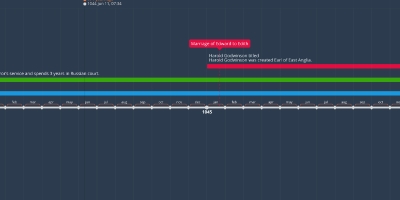Ealdred is archbishop of York and bishop of Worcester (26 déc. 1060 – 31 mars 1062)
Description:
Ealdred was rewarded with the administration of the see of Hereford, which he held until 1061, and was appointed Archbishop of York. The diocese had suffered a serious raid from the Welsh in 1055, and during his administration, Ealdred continued the rebuilding of the cathedral church as well as securing the cathedral chapter's rights. Ealdred was granted the administration in order that the area might have someone with experience with the Welsh in charge.In 1058 Ealdred made a pilgrimage to Jerusalem, the first English bishop to make the journey. He travelled through Hungary, and the Anglo-Saxon Chronicle stated that "he went to Jerusalem in such state as no-one had done before him". While in Jerusalem he made a gift of a gold chalice to the church of the Holy Sepulchre. It is possible that the reason Ealdred travelled through Hungary was to arrange the travel of Edward the Exile's family to England. Another possibility is that he wished to search for other possible heirs to King Edward in Hungary. It is not known exactly when Edward the Exile's family returned to England, whether they returned with Edward in 1057, or sometime later, so it is only a possibility that they returned with Ealdred in 1058.
Cynesige, the archbishop of York, died on 22 December 1060, and Ealdred was elected Archbishop of York on Christmas Day, 1060. Although a bishop was promptly appointed to Hereford, none was named to Worcester, and it appears that Ealdred intended to retain Worcester along with York, which several of his predecessors had done.[43] There were a few reasons for this, one of which was political, as the kings of England preferred to appoint bishops from the south to the northern bishoprics, hoping to counter the northern tendency towards separatism. Another reason was that York was not a wealthy see, and Worcester was. Holding Worcester along with York allowed the archbishop sufficient revenue to support himself.[46]
In 1061 Ealdred travelled to Rome to receive the pallium, the symbol of an archbishop's authority. Journeying with him was Tostig, another son of Earl Godwin, who was now earl of Northumbria. William of Malmesbury says that Ealdred, by "amusing the simplicity of King Edward and alleging the custom of his predecessors, had acquired, more by bribery than by reason, the archbishopric of York while still holding his former see." On his arrival in Rome, however, charges of simony, or the buying of ecclesiastical office, and lack of learning were brought against him, and his elevation to York was refused by Pope Nicholas II, who also deposed him from Worcester. The story of Ealdred being deposed comes from the Vita Edwardi, a life of Edward the Confessor, but the Vita Wulfstani, an account of the life of Ealdred's successor at Worcester, Wulfstan, says that Nicholas refused the pallium until a promise to find a replacement for Worcester was given by Ealdred. Yet another chronicler, John of Worcester, mentions nothing of any trouble in Rome, and when discussing the appointment of Wulfstan, says that Wulfstan was elected freely and unanimously by the clergy and people. John of Worcester also claims that at Wulfstan's consecration, Stigand, the archbishop of Canterbury extracted a promise from Ealdred that neither he nor his successors would lay claim to any jurisdiction over the diocese of Worcester. Given that John of Worcester wrote his chronicle after the eruption of the Canterbury–York supremacy struggle, the story of Ealdred renouncing any claims to Worcester needs to be considered suspect.
For whatever reason, Ealdred gave up the see of Worcester in 1062, when papal legates arrived in England to hold a council and make sure that Ealdred relinquished Worcester. This happened at Easter in 1062. Ealdred was succeeded by Wulfstan, chosen by Ealdred, but John of Worcester relates that Ealdred had a hard time deciding between Wulfstan and Æthelwig. The legates had urged the selection of Wulfstan because of his saintliness. Because the position of Stigand, the archbishop of Canterbury, was irregular, Wulfstan sought and received consecration as a bishop from Ealdred. Normally, Wulfstan would have gone to the archbishop of Canterbury, as the see of Worcester was within Canterbury's province. Although Ealdred gave up the bishopric, the appointment of Wulfstan was one that allowed Ealdred to continue his considerable influence on the see of Worcester. Ealdred retained a number of estates belonging to Worcester.
Ajouté au bande de temps:
Date:
26 déc. 1060
31 mars 1062
~ 1 years and 3 months

